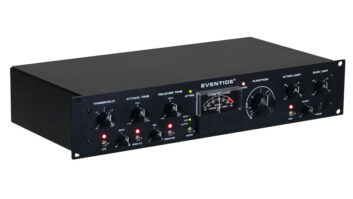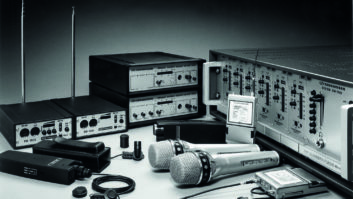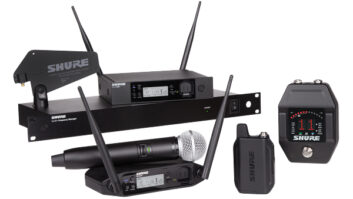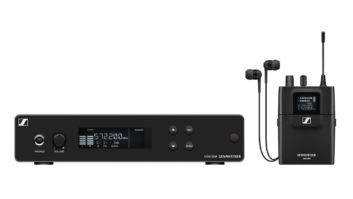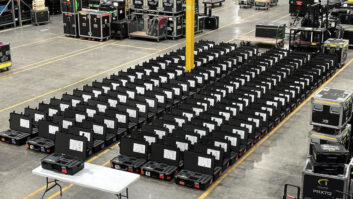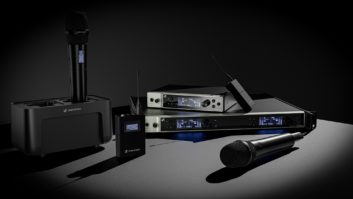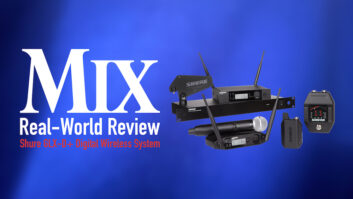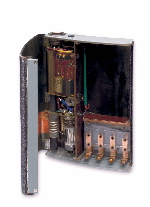
The first Sennheiser transmitter (pictured), created in 1957, had a short life span because it required a tube and far too many batteries. The follow-up Sennheiser SK 1002 pocket transmitter, introduced in 1958, was considerably smaller thanks to transistors. Around the time of its launch, Sennheiser teamed with Telefunken to create wireless microphones under the brand name Mikroport, which transmitted on two channels licensed by the German postal authorities.
More technological improvements followed. In 1962, Sennheiser introduced the professional-grade SK 1004 and the first wireless microphone for amateurs, Mikroport Junior, which allowed users to listen to their own wireless transmissions live over a normal UKW radio. In the late 1960s, the SK 1008, a transmitter with a plug-on microphone head, and the small MKH 124/125, an RF condenser microphone with a frequency response of 20 to 20,000Hz, were both used on countless TV shows. In the late 1970s, Sennheiser introduced its first modular rackmount receiver, the EM 1026, which housed up to six receiver modules that featured large-signal response, high interference resistance and an easy-to-use interface.
Also in the late 1970s, Sennheiser engineered a leap forward in noise-reduction technology with HiDyn, a proprietary compander system. The ultraquiet HiDyn technology found its first use in the SK 1012 transmitter.
The 1980s heralded a new era in which UHF broadcasting made wireless audio transmissions dramatically more robust. In 1982 and 1983, Sennheiser developed the SKM 4031 TV handheld transmitter, the SK 2012 TV pocket transmitter, the EM 1036 TV receiver system and the EK 2012 TV minireceiver.
Excellent RF technology, in combination with tiny clip-on microphones, put Sennheiser wireless equipment onstage in major musicals, such as Cats and Starlight Express. In 1987, Sennheiser engineers developed remote computer monitoring for the EM 1036; it allowed sound engineers to control and monitor all-important transmitter and receiver parameters on a single computer.
In 1988, the SER 20 reporting transmitter was the first Sennheiser product to make use of new PLL synthesizer technology. It allowed the Mikroport to be used in the UHF frequency band with complete flexibility and meant that large wireless multichannel microphone systems could be created without interference. In the early 1990s, Sennheiser introduced the wireless SKM 5000 (handheld transmitter), the SK 50 and SK 250 (bodypack transmitters) as well as the modular receiver system EM 1046 (later renamed the 5000 series). HiDyn plus technology further enhanced noise suppression.
In 1999, Sennheiser created its most successful wireless range to date. The Evolution Wireless series featured three product lines covering users in almost every wireless sector. Miniaturization continued, and in 2001, the SK 5012 bodypack transmitter was introduced (the entirety of which was smaller than the battery pack on 1993’s SK 250). In 2002, Sennheiser teamed with studio-microphone expert Georg Neumann to create the SKM 5000 N, which combined a Sennheiser transmitter with a Neumann capsule.
“Of course, it would be great if we could simply enjoy this wireless anniversary and our top new products, like the SKM 5200 handheld transmitter or the SK 5212 bodypack transmitter,” says Volker Bartels, speaker of the Sennheiser Executive Committee. “But all of our success has been placed in jeopardy by the impending sell-off of the UHF spectrum. If a spectrum isn’t reserved for wireless microphones, the consequences for the whole entertainment sector will be disastrous. It will spell the end of lavish stage shows, major productions, concert tours and musicals. Complete freedom of movement onstage—as made possible by wireless microphones and wireless monitoring—will be a thing of the past. But I’m an optimist. I think that everyone involved can reach a sensible solution together, with our pioneering RF technology guaranteeing breathtaking stage shows for the future.”
For more information about Sennheiser, visit www.sennheiserusa.com.
